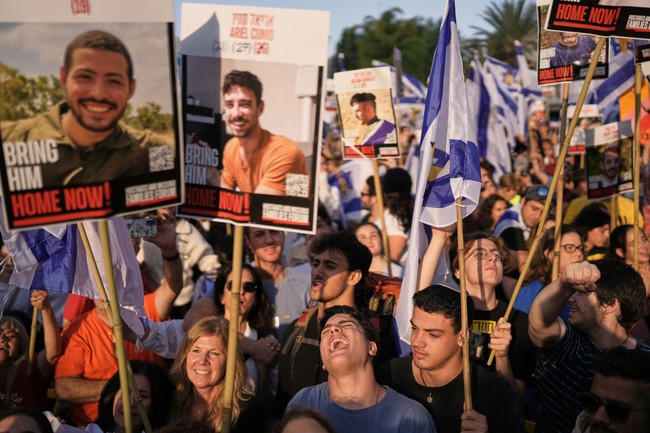
This process has been moving very slowly but it has been moving. Today, Israel identified another body released by Hamas as that of a hostage taken on 10/7.
Israel on Friday identified the body of a hostage released from Gaza as Meny Godard, a 73-year-old who was killed during the Hamas attack of Oct. 7, 2023. The return of his body brings the number of deceased hostages still in Gaza to three.
The bodies of 25 others have now been released as part of a ceasefire and hostages-for-prisoners exchange deal between Israel and Hamas that began in mid-October. Under the same agreement, Israel has returned the bodies of hundreds of Palestinians, according to the Gaza Health Ministry.
Prior to the release of Godard’s body yesterday, the last time a body was released to Israel was Sunday. Early on, Hamas was releasing several bodies each day or every few days. But the pace has slowed, allegedly because Hamas is trying to locate the remaining bodies. But we all learned at the end of October that Hamas was lying and merely pretending to discover bodies buried under the rubble.
In any case, there are only three deceased hostages left—Ran Gvili, Dror Or and Sudthisak Rinthalak. So there is probably a limit to how much longer Hamas can drag this out. Meanwhile, we’re starting to see exactly why they have been playing this game with the remains of the hostages. It has given them time to reestablish their control of Gaza.
From regulating the price of chicken to levying fees on cigarettes, Hamas is seeking to widen control over Gaza as U.S. plans for its future slowly take shape, Gazans say, adding to rivals’ doubts over whether it will cede authority as promised.
After a ceasefire began last month, Hamas swiftly reestablished its hold over areas from which Israel withdrew, killing dozens of Palestinians it accused of collaborating with Israel, theft or other crimes. Foreign powers demand the group disarm and leave government but have yet to agree who will replace them.
Now, a dozen Gazans say they are increasingly feeling Hamas control in other ways. Authorities monitor everything coming into areas of Gaza held by Hamas, levying fees on some privately imported goods including fuel as well as cigarettes and fining merchants seen to be overcharging for goods, according to 10 of the Gazans, three of them merchants with direct knowledge…
Gaza City activist and commentator Mustafa Ibrahim said Hamas was exploiting delays in the Trump plan “to bolster its rule”. “Will it be allowed to continue doing so? I think it will continue until an alternative government is in place,” he said.
Hamas denies that it is trying to solidify power and claims it is just trying to regulate prices to control the chaos in the region. But an earlier report suggests another possibility. Hamas is looking to settle into the half of Gaza which Israel no longer controls.
A de facto partition of Gaza between an area controlled by Israel and another ruled by Hamas is increasingly likely, multiple sources said, with efforts to advance U.S. President Donald Trump’s plan to end the war beyond a ceasefire faltering.
Six European officials with direct knowledge of the efforts to implement the next phase of the plan told Reuters it was effectively stalled and that reconstruction now appeared likely to be limited to the Israel-controlled area…
The next stage of the plan foresees Israel withdrawing further from the so-called yellow line agreed under Trump’s plan, alongside the establishment of a transitional authority to govern Gaza, the deployment of a multinational security force meant to take over from the Israeli military, the disarmament of Hamas and the start of reconstruction.
But the plan provides no timelines or mechanisms for implementation. Meanwhile, Hamas refuses to disarm, Israel rejects any involvement by the Western-backed Palestinian Authority, and uncertainty persists over the multinational force.
Without a major push by the United States to break the impasse, the yellow line looks set to become the de facto border indefinitely dividing Gaza, according to 18 sources, among them the six European officials and a former U.S. official familiar with the talks.
From Hamas’ perspective it may be better to retain control of half of Gaza with no money for reconstruction than to move forward with disarmament and lose control of everything. We already know Hamas doesn’t care what happens to the civilians of Gaza, at least not nearly as much as it cares about fighting Israel. So the fact that this outcome will be miserable for those civilians in Gaza doesn’t really factor in.
Hamas may feel, with some justification, that they can use the new situation of a divided Gaza to make a plea for international relief regardless of the fact that they have not ceded control. And once the money starts flowing they are right back in business, planning the next attack.
In any case, it looks for now like that is their plan. Maybe some movement toward the original peace plan will happen once the final remains of Israeli hostages are returned. Or maybe those remaining bodies will never be “found” to stall the process indefinitely.
Join Hot Air VIP and use the promo code FIGHT to get 60% off your VIP membership!








